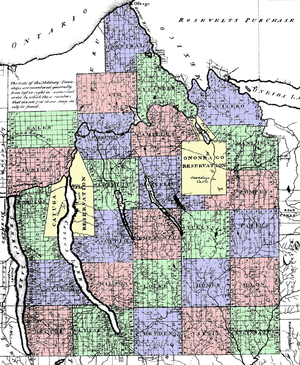- Central New York Military Tract
-
The Military Tract of Central New York, also called the New Military Tract, consisted of nearly two million acres (8,000 km²) of bounty land set aside to compensate New York’s soldiers after their participation in the Revolutionary War.
The United States Congress had already guaranteed each soldier at least 100 acres (0.4 km²) at the end of the war (depending on rank), but by 1781, New York had enlisted only about half of the quota set by the U.S. congress and needed a stronger incentive. The state legislature authorized an additional 500 acres (2 km²) per soldier, using land from 25 Military Tract Townships to be established in central New York State. Each of the townships was to comprise 100 lots of 600 acres (2.4 km²) each. Three more such townships were later added to accommodate additional claims at the end of the war.
The townships were at first numbered (1 through 28), but were later given (mostly) classical Greek and Roman names, along with a few honoring English authors:
1. Lysander
2. Hannibal
3. Cato
4. Brutus
5. Camillus
6. Cicero
7. Manlius8. Aurelius
9. Marcellus
10. Pompey
11. Romulus
12. Scipio
13. Sempronius
14. Tully15. Fabius
16. Ovid
17. Milton
18. Locke
19. Homer
20. Solon
21. Hector22. Ulysses
23. Dryden
24. Virgil
25. Cincinnatus
26. Junius
27. Galen
28. SterlingThe tract covered the present counties of Cayuga, Cortland, Onondaga, and Seneca, and parts of Oswego, Tompkins, Schuyler and Wayne. Most of these township names are reflected in current town names in these counties, but the area of the military townships do not correspond exactly with any of the modern towns, which only cover a fraction of the original townships.
The names themselves have been attributed to Robert Harpur, a clerk in the office of New York's Surveyor General, Simeon De Witt. Harpur apparently had an interest in classical literature.
Townships were as far as geographically feasible made up of a 10x10 square of mile-square (640 acre) lots; 40 acres (160,000 m2) were used for boundary roads, leaving 600 acres (2.4 km²) to be deeded in each lot. Ninety-four (94) lots in each Township were to be deeded, with the other six (6) reserved for public purposes such as churches and schools.
The portion of the Military Tract north of Seneca Lake (i.e. townships of Galen and Junius) was divided by the New Preemption Line from land to its west assigned by the Treaty of Hartford of 1786 to Massachusetts. The tract immediately to the west became the Phelps and Gorham Purchase. The west limit of most of the tract was Seneca Lake.
Two Indian reservations were included in the Tract, for the Onondaga and Cayuga. All of the Cayuga and most of the Onondaga (including the City of Syracuse) were taken a few years later by New York State by treaties whose legality has been repeatedly challenged, since following the Trade and Intercourse Act of 1790 only the United States could conclude treaties with Indians.
Timeline
- 20-March-1781: New York legislature authorizes a military tract as part of law to raise its quota of regiments
- 19-October-1781: Cornwallis surrenders, end of Revolutionary War
- 25-July-1782: approximate boundaries (to be surveyed) of original 25 townships established by NY legislature
- 03-September-1783: Treaty of Paris, peace settlement with Great Britain
- 12-September-1788: Treaty of Fort Stanwix: Indian title to the military tract was extinguished
- 1789: military tract surveyed
- 03-July-1790: Names given to the first 25 townships at a meeting of the Commissioners of the Land Office of New York, chairman Governor George Clinton
- 1791: lots drawn and assigned to settlers
- 1791: name given to Township 26 (Junius) by Commissioners
- 1792: name given to Township 27 (Galen) by Commissioners
- 1795: name given to Township 28 (Sterling) by Commissioners
- 1799: deadline to settle
References
Categories:- New York in the American Revolution
- Former regions and territories of the United States
- Military operations in Syracuse, New York
Wikimedia Foundation. 2010.

